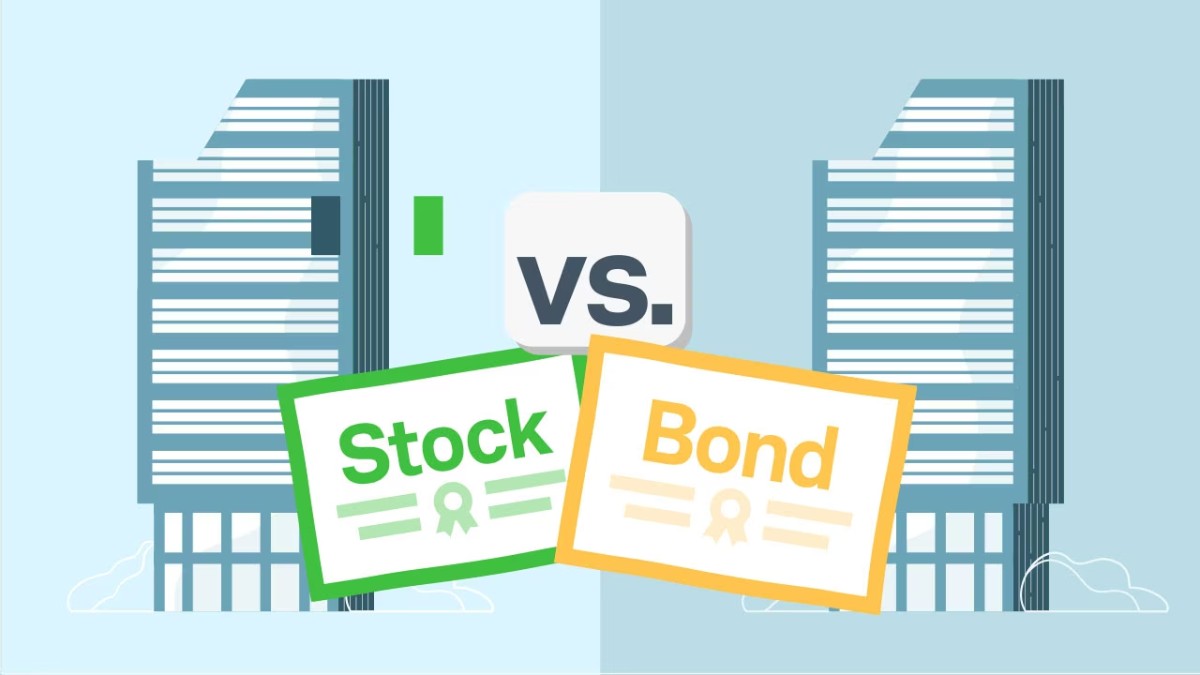Business
What You Should Know about Bonds vs Stocks

It’s common to discuss stocks and bonds together as if they were comparable investment categories. But because they are distinct from one another and because one’s advantages can outweigh its disadvantages, a lot of people invest in both at the same time.
A company’s shares, or stocks, grant ownership rights over a certain percentage of the profits made by the company.
Bonds are securities that governments, businesses, and other organizations sell to raise money.
Before making an investment, investors should understand the differences in the risks and potential profits between stocks and bonds.
Stocks: pros and cons
PROS:
- Possibility of capital appreciation.
- Often, individual stocks and industry sectors do better than the overall market (sometimes significantly).
- Dividends, which are another form of income from stock ownership, are paid by certain stocks as well.
- In general, stocks do better than inflation.
- Can be bought for just one dollar.
- The majority of investment brokers provide commission-free stock trading.
- Because the most well-liked stocks are very liquid, buying and selling them is quick and simple.
CONS:
- You can lose the money you invested. The entire investment in a single stock may lose value in certain situations.
- Developing and managing an equities portfolio demands superior investment expertise.
- While stocks tend to perform better than other asset classes in the long run, they are subject to sharp price fluctuations in the short term.
Bonds: pros and cons
PROS:
- Bonds typically pay interest at scheduled intervals at a fixed rate.
- Principal protection when bonds are held until maturity.
- Possibility of capital appreciation if securities are sold before maturity and interest rates drop.
- Short-term price levels are generally stable.
- In general, bonds yield higher interest rates than bank investments.
CONS:
- Sometimes bond issuers default, completely devaluing the bond.
- A bond’s market value may significantly decrease if the issuer experiences financial difficulties or declares bankruptcy.
- Bonds may lose market value if interest rates increase after they are bought, but if they are held until maturity, the full face value will be paid.
- In the long run, stocks outperform bonds.
- The real rate of return on bonds may decrease or cease to exist due to inflation.
How to buy stocks or exchange-traded funds (ETFs)
Publicly traded companies issue stocks. Stock exchanges, like the NASDAQ and the New York Stock Exchange (NYSE), allow traders to trade stocks. International stock exchanges handle the trading of stocks issued by non-US companies. Some stocks are known as over-the-counter (OTC) stocks because they are not traded on official exchanges.
You can expand your portfolio by buying individual stocks. As an alternative, you can put money into mutual funds that own stocks. Exchange-traded funds are among the most well-liked fund categories (ETFs). Since the inception of these funds, their performance has been linked to an underlying index, such as the Russell 2000, the S&P 500, or the Dow Jones Industrial Average. Currently, however, ETFs come in a variety of flavors, including index-tracking, actively managed, and alternative asset-holding ETFs like Bitcoin.
ETF shares trade on major stock exchanges, just like shares of individual stocks. Typically, they can be bought for the same amount as a single fund share (or fractional share). Thousands of different ETFs are available for purchase. Many focus on particular markets, such as consumer goods, healthcare, energy, technology, or different regional funds that hold stocks in Europe, Latin America, Japan, and other parts of the world.
Based on market capitalization, other ETFs have a focus on equities. Large-cap, mid-cap, small-cap, and even micro-cap stocks can be among them. The reason for this kind of segmentation is that different market segments perform better than the overall market at different points in time.
Investment brokers like Ally Invest and Public allow customers to purchase both individual stocks and exchange-traded funds (ETFs). You can open an account on either platform with no money in it, and you can trade stocks and ETFs without paying commissions. With either broker, you can even decide to hold a combination of individual stocks and ETFs.
How to buy bonds or ETFs
Typically, corporate bonds are offered in $1,000 minimum denominations. It might be feasible to buy bonds in smaller denominations, though. Investing in corporate bonds with a small amount of capital through an exchange-traded fund (ETF) with a bond focus is a more frictionless method. Buying a single share in a bond ETF gives you access to a whole portfolio of bonds because you can invest in an ETF for less than $1,000.
Bonds can be bought through the same investment brokers that sell stocks. Corporate bonds, however, are typically not offered commission-free, unlike stocks. The majority of brokers impose fees on bond purchases and sales. This will differ depending on the broker, so compare commissions from several brokers to find the best deal, especially if you intend to invest in bonds on a regular basis.
Additionally, $100 denomination US Treasury bonds are available for purchase. Treasury bonds are available through investment brokers, but TreasuryDirect offers commission-free purchasing and holding of Treasury bonds. The terms of US Treasury bonds are either 20 or 30 years. The Treasury also offers shorter-term securities for purchase. Treasury notes have terms of two to ten years, while Treasury bills have durations of months or years.
The bond’s interest rate decreases with increasing bond rating. This is because the bond’s quality and the rate paid are inversely correlated. Issues with lower interest rates and a lower default rate are considered stronger. On the other hand, weaker securities have higher interest rates to compensate investors for taking on a greater default risk.
Interest rate risk
Interest rate fluctuations are another risk associated with bonds. The market interest rate and bonds are inversely correlated. The market value of a bond will decrease if the interest rate rises after it has been purchased; typically, this will bring the yield closer to the going rate.
On the other hand, if interest rates decline after the bond is bought, the bond’s market value may rise to the point where the yield is close to the going rate. In such a case, the bond may be sold for a capital gain before maturity.
Interest rate risk is materially impacted by the bond’s remaining term. A newly issued 30-year bond, for instance, may lose up to 20% of its value if you buy it at 4% and the going rate increases to 5%. Interest rate fluctuations have a significant impact on the bond because it has been decades before it matures.
On the other hand, since the bond will mature in five years, buying an existing 30-year bond will have little effect on its market value because it will pay out quickly.
Some investors are persuaded to invest in bonds through an ETF by the uncertainty surrounding bond quality and the possibility of interest rate fluctuations. Individual bond investments take more skill, but if you hold a quality bond to maturity, you will receive interest at the original interest rate in addition to your principal back.
When is the right time to buy bonds and/or stocks?
It is a common recommendation of investment advisors to diversify an investment portfolio by holding both stocks and bonds. Long-term value retention in bonds enables them to function as a counterbalance during periods of stock market decline. Bonds additionally increase a portfolio’s cash flow and produce interest income.
Given that both asset classes are advised, the portfolio’s allocation is most important.
It is advised that younger investors, those in their 20s and 30s, maintain a portfolio with a higher proportion of stocks. Although specific recommendations may differ, generally speaking, a larger allocation is advised because an investor has decades to make up for potential losses. Furthermore, a portfolio with a higher stock allocation is probably going to be larger in the long run than one with a higher bond allocation.
On the other hand, older investors—especially those who are close to retirement—should think about allocating more money to bonds. An investor who is 55 years of age or older may keep 40% of bonds and 60% of stocks in their portfolio. This blend will lessen volatility during downturns and offer a more steady stream of income.
These allocations can be changed based on an individual’s risk tolerance regardless of age. A younger investor who is less risk averse might want to allocate more of their portfolio to bonds than is typically advised for their age group. A higher allocation to stocks might be preferred by an older investor with a higher risk tolerance.
It’s critical to understand corporate bond ratings if you decide to buy individual bonds. Renowned rating agencies, like Moody’s and Standard & Poor’s, assign ratings to bonds at the time of issuance and again during interval reviews.
-

 Business4 weeks ago
Business4 weeks agoHow to fill MSME Form 1? Step-by-Step Guide
-

 Gadget4 weeks ago
Gadget4 weeks agoAfter Grand Success on BLDC Ceiling Fan, Eff4 Is Launching Smart Bulb
-

 Festivals & Events4 weeks ago
Festivals & Events4 weeks agoGoogle Celebrates Cherry Blossom Season with Animated Doodle
-

 Business2 weeks ago
Business2 weeks agoPrakash and Kamal Hinduja: Driving Social and Environmental Change
-
Education3 weeks ago
Fred DuVal: University Leadership as a Critical Resource for Climate Change Research and Life-Saving Solutions
-

 Sports4 weeks ago
Sports4 weeks ago2025 NASCAR Craftsman Truck Series Baptist Health 200 at Homestead-Miami Speedway: Race Preview, Prediction, Schedule, Entry List, Drivers to Watch and How to Watch
-

 Health2 weeks ago
Health2 weeks agoThe Hinduja Brothers Commitment to Global Health: Empowering Communities Across Borders
-

 Cryptocurrency2 weeks ago
Cryptocurrency2 weeks agoDesigned For The Masses: How Akasha (AK1111) Is Unlocking Crypto For The Next Billion Users


















